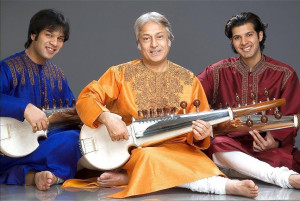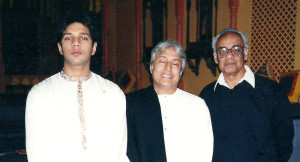Sarod Virtuoso, Khan Saheb Amjadji to perform in Sydney
Amjad Ali Kahn with Ayaan Ali Khan and Amaan Ali Khan
By K Raman
After a protracted wait, Amjadji will be at the Seymour theatre on April, 24, 2015, to perform, thanks to Sri. Krishnamoorthy, Head of Soorya Organisation and Sri. Sudhir Das, The Sydney chapter chief of Soorya enterprises. This time we will hear the trio of greats consisting of Khan Saheb and his illustrious sons who will be on the podium.
The first impression I got as I met Ustadji many years ago was the very serene look on his face, with no tendency to talk overtly. He looked like a pious hermit, an introvert, fully engrossed in his music. Whatever he utters are well constructed and thought provoking logical talk connected to musical melodies and laya pattern with the intense mathematics governing them. I soon realised that he lives in a ”˜musical bubble’ on his own untouched by ego, hatred or jealousy towards fellow musicians.
On his advent as an 11 year old, he had no notion of his pedigree, lineage, musical tradition of his family of six unbroken generations of Sarrod playing and the job he was expected to do over the long years to follow. He only wanted his Sarod to sing for him and nothing else. He is a direct disciple of Tansen, a musician’s musician. Lamps lit itself when Tansen sang, and he could bring rain during draught by singing in Raga Amrithavarshini.
Kris Raman (left) with the maestro
When I met him some 15 odd years ago, I understood straight away that he is a traditionalist in his music and day to day life. As I addressed him either as Khan Saheb or Usthatji or Amjadji, that too every time I brought his name up, he complimented me for doing so. He said “you are respecting my music as well as me its practitioner”
Sarod is a Lute like stringed instrument. It generates a melodious, deep, introspective and weighty sound in the hands of a maestro and very suited for Indian classical music, with the resonant, reverberating notes it produces. It is the ”˜Sympathetic strings’, that does the trick.
Sarod is noted for its pristine total quality, capable of generating a wide spectrum of emotions, and a varied related dynamics it can offer. Sarod is a combined version of Afghan Rabat, Sursingar, and Saraswathi Veena, with a story to tell of 2500 years. Tansen was the one who introduced Sarod to Indian classical music. One of his descendants Usthad Jaffar Khan is the one who made structural modifications to Sarod by introducing metal finger boards and metal strings in its construction. It remained fretless all along. Jaffar Khan did so to facilitate and execute ”˜Meeds’ (glides), curves and minute musical aesthetic features. It was Janab Alauddin Khan who made many more changes to Sarod bringing it to its modern status incorporating 15 Tarab strings, 3 Chicari strings, 4 main or primary strings and 3 Thaat strings. Hafiz Ali Khanji is the father of legendary Amjadji, the sixth loop of the Sansia Bangeshi lineage. Amjadji is a past master to coax his instrument to bring out scintillating busts of Raga sancharas, cloaked with ”˜Laya prastaras’ besides decorating it with many innovative and mind boggling Manodharma beautifications. His classy methodology in elaborating ragas and innovative swara ”˜padhathi’ is one of its kinds. Within no time he is able to transport avid listeners to a musically celestial region. The young Khans are reverently addressed as “the coming Masters” by seasoned scribes. Khan Saheb says “music detaches me from the rest of the world; moreover I spent 8 to 10 hours of each day on Riaz, perfecting my music endlessly repeating the ”˜sangathis’; I have no time to do other things”
Khan Saheb as tradition warrents begins his concerts with a Raaga Aalap, a set of highly subtle, meditative musical movements. His skill lies in the usage of ascending and descending of notes variation, in which some may be flattened or sharpened to suit the mood and need. In short each note brings up a particular flavour. Such a maestro when arrives with his two brilliant sons should be welcomed and heard to in the classy venue of Seymour centre. Hope we could give him a packed hall.
Short URL: https://indiandownunder.com.au/?p=4600


